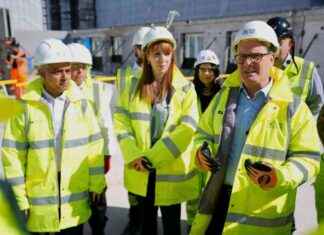A summit brings together, Monday, April 24 in Belgium, nine European countries to seal their common ambition to increase their wind turbine capacities tenfold in the North Sea, a colossal industrial challenge to accelerate the decarbonization of the continent.
The Ostend meeting, where French President Emmanuel Macron, German Chancellor Olaf Scholz and Dutch Prime Minister Mark Rutte will meet, aims to develop wind farms, connection infrastructure, industrial chains and energy projects. “green” hydrogen. Leaders from Belgium, Ireland, Denmark and Luxembourg – major project funders – as well as Norway and the UK will also be present.
Rather than establishing specific partnerships, it is a question of coordinating national policies, explained to the press last week the Belgian Prime Minister, Alexander De Croo, at the initiative of the “North Sea summit”. “The key is not so much to state ambitious goals as to be quick to execute,” he said, calling for increased technological “standardization” to build faster and “better alignment of calls for ‘bids’ so as not to saturate supply chains.
“Together the ambition is around 300 gigawatts [GW] by 2050,” said De Croo. This is ten times more than the capacities currently installed. The goal for 2030 is to at least quadruple the current fleet, he added.
In France, approximately 0.5 GW of offshore wind power
While the United Kingdom has 14 GW of offshore wind power and Germany 8 GW, the capacities of Denmark, Belgium and the Netherlands are between 2 and 3 GW, and those of France and Norway at around 0.5 GW. “The orders of magnitude are gigantic (…). With us as with our neighbours, offshore wind power will probably be the main source of renewable energy production between 2030 and 2050, far ahead of solar and onshore wind power, ”we observe at the Elysée. France is targeting 40 GW of offshore wind power in service by 2050 on all coasts.
In the shallow North Sea, wind turbines “can be installed in large numbers” not too far from the coast, “under wind conditions that can produce a lot of” green energy at a “particularly competitive” cost, adds the same source. After a first meeting of four countries in May 2022, this second “North Sea summit” is part of Europe’s climate objectives as well as the desire to cut its dependence on imported fossil fuels, a consequence of the war in Ukraine.
The EU recently agreed to double the share of renewables in its energy consumption to 42.5% by 2030, in particular by speeding up the authorization procedures for infrastructure. Brussels also offered regulatory relief for green industries in mid-March.
European industry should thus manufacture within five years the equivalent of 20 GW of offshore wind turbines per year, against a capacity of around 7 currently, at the risk of saturated factories and bottlenecks on the components. The total cost promises to be colossal: at the end of 2020, Brussels estimated the investment needs at 800 billion euros if the EU alone aimed for 300 GW of offshore wind power by 2050.
One of the difficulties in achieving this objective is Europe’s dependence on imports of critical components (rare earths, etc.), particularly from China. Environmental NGOs are calling for marine biodiversity impact studies not to be rushed, and the WindEurope association underlines the constraints linked to fishing and transport.






